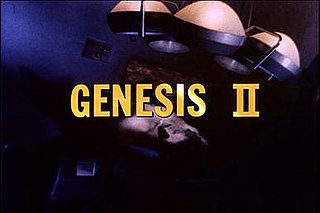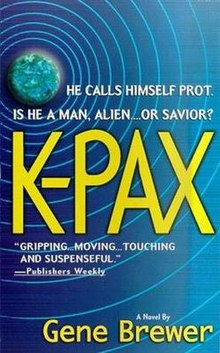
John Wyndham Parkes Lucas Beynon Harris was an English science fiction writer best known for his works published under the pen name John Wyndham, although he also used other combinations of his names, such as John Beynon and Lucas Parkes. Some of his works were set in post-apocalyptic landscapes. His best known works include The Day of the Triffids (1951) and The Midwich Cuckoos (1957), the latter filmed twice as Village of the Damned.

Apocalyptic and post-apocalyptic fiction is a subgenre of science fiction, science fantasy, dystopia or horror in which the Earth's civilization is collapsing or has collapsed. The apocalypse event may be climatic, such as runaway climate change; astronomical, such as an impact event; destructive, such as nuclear holocaust or resource depletion; medical, such as a pandemic, whether natural or human-caused; end time, such as the Last Judgment, Second Coming or Ragnarök; or more imaginative, such as a zombie apocalypse, cybernetic revolt, technological singularity, dysgenics or alien invasion.
Capgras delusion is a psychiatric disorder in which a person holds a delusion that a friend, spouse, parent, or other close family member has been replaced by an identical impostor. It is named after Joseph Capgras (1873–1950), a French psychiatrist.

The Lathe of Heaven is a 1971 science fiction novel by American writer Ursula K. Le Guin. The plot concerns a character whose dreams alter past and present reality. The story was serialized in the American science fiction magazine Amazing Stories. The novel received nominations for the 1972 Hugo and the 1971 Nebula Award, and won the Locus Award for Best Novel in 1972. Two television film adaptations were released: the PBS production, The Lathe of Heaven (1980), and Lathe of Heaven (2002), a remake produced by the A&E Network.
Gene Brewer is an American writer, the author of the K-PAX book series, about a man who claims to be a visiting extraterrestrial from a planet called K-PAX: K-PAX (1995), On a Beam of Light (2001), K-PAX III: The Worlds of Prot (2002), K-PAX IV (2007) and Prot's Report, a brief natural history of the Earth, which appears in K-PAX: The Trilogy, an omnibus edition of the first three K-PAX books. The first book in the series was made into a film in 2001; it stars Kevin Spacey and Jeff Bridges.
Works of fiction dealing with mental illness include:

The Sands of Mars is a science fiction novel by English writer Arthur C. Clarke. While he was already popular as a short story writer and as a magazine contributor, The Sands of Mars was also a prelude to Clarke's becoming one of the world's foremost writers of science fiction novels. The story was published in 1951, before humans had achieved space flight. It is set principally on the planet Mars, which has been settled by humans and is used essentially as a research establishment. The story setting is that Mars has been surveyed but not fully explored on the ground. The Sands of Mars was Clarke's first published novel.

A World Out of Time is a science fiction novel by Larry Niven and published in 1976. It is set outside the Known Space universe of many of Niven's stories, but is otherwise fairly representative of his 1970s hard science fiction novels. The main part of the novel was originally serialized in Galaxy magazine as "Children of the State"; another part was originally published as the short story "Rammer". A World Out of Time placed fifth in the annual Locus Poll in 1977.

Genesis II is a 1973 American made-for-television science fiction film created and produced by Gene Roddenberry and directed by John Llewellyn Moxey. The film, which opens with the line, "My name is Dylan Hunt. My story begins the day on which I died", is the story of a 20th-century man thrown forward in time, to a post-apocalyptic future, by an accident in suspended animation. The film stars Alex Cord, Mariette Hartley, Ted Cassidy, Percy Rodrigues, Harvey Jason, Titos Vandis, Bill Striglos, Lynne Marta, Harry Raybould, and Majel Barrett.

Planet Earth is a 1974 American made-for-television science fiction film that was created by Gene Roddenberry, written by Roddenberry and Juanita Bartlett. It first aired on April 23, 1974 on the ABC network, and stars John Saxon as Dylan Hunt. It was presented as a pilot for what was hoped to be a new weekly television series. The pilot focused on gender relations from an early 1970s perspective. Dylan Hunt, confronted with a post-apocalyptic matriarchal society, muses, "Women's lib? Or women's lib gone mad..." The film also stars Diana Muldaur, Ted Cassidy, Janet Margolin, Christopher Cary, Corrine Camacho, and Majel Barrett. Marc Daniels directed the film.

K-PAX is a 2001 American-German science fiction-mystery film based on Gene Brewer's 1995 novel of the same name, directed by Iain Softley, starring Kevin Spacey, Jeff Bridges, Mary McCormack, and Alfre Woodard. The film is about a psychiatric patient who claims to be an alien from the planet K-PAX. During his treatment, the patient demonstrates an outlook on life that ultimately proves inspirational for his fellow patients and especially for his psychiatrist.

Ron Miller is an American illustrator and writer who lives and works in South Boston, Virginia. He now specializes in astronomical, astronautical and science fiction books for adults and young adults.

Forge of Heaven is a science fiction novel by American science fiction and fantasy author C. J. Cherryh. It was first published in June 2004 in the United States by HarperCollins under its Eos Books imprint.

Hammerfall is a science fiction novel by American science fiction and fantasy author C. J. Cherryh. It was first published in June 2001 in the United States by HarperCollins under its Eos Books imprint. It was also serialized in two parts as Ribelle Genetico and Il Pianeta del Deserto in the Italian science fiction magazine, Urania, published in issue 1425 in October 2001, and issue 1430 in January 2002, respectively.

The planetary systems of stars other than the Sun and its solar system are a staple element in much science fiction. Vega is a blue-white star in the constellation Lyra that is frequently featured in works of science fiction. Like its bright cousins Sirius, Deneb, and Altair, it is classified as a star of spectral type A. Roughly two and a half times the size of the sun, it is 40 times as luminous and, together with Arcturus and Sirius, one of the most radiant stars in the galactic neighborhood. Its luminosity joins with its relative proximity to the Earth—it is only 25 light-years away—to make it the fifth-brightest star in the night sky. Vega is rendered decidedly oblate by its rapid rate of rotation, and since it is pole-on to the sun, it appears significantly larger to earthbound observers than it actually is. For this and a variety of other reasons Vega has been extensively studied by astronomers, leading it to be termed "arguably the next most important star in the sky after the sun."
Altair is a luminous white star in the constellation Aquila frequently featured in works of science fiction.

Aldebaran is a type K5 giant star in the constellation Taurus that is frequently featured in works of science fiction. Aldebaran is a subject for ancient myths in multiple cultures and, in more recent times, the mythologizing of science fiction.

Red Orc's Rage (1991) is a recursive science fiction novel by American writer Philip José Farmer, part of his "World of Tiers" series. The plot of the book was inspired by the work of American psychiatrist A. James Giannini, M.D, who used earlier books in Farmer's series as role-playing tools and aids to self-analysis. This technique was developed at Yale University and further expanded by Dr. Giannini at Ohio State University. The technique is properly called "projective psychotherapy". It involves immersing the patients in a fictional world which is accessible to the psychiatrist. It is subject to alternative interpretation but not to change. By utilizing a structured fantasy world the subconscious can be directly accessed without confronting resistances of the conscious mind.

Man Facing Southeast is a 1986 Argentine science fiction film written and directed by Eliseo Subiela and starring Lorenzo Quinteros and Hugo Soto.

Semiosis is a 2018 science fiction novel by American writer and translator Sue Burke. It is her debut novel and is the first book of her Semiosis Duology series. It was first published in February 2018 in the United States by Tor Books, and in August 2018 in the United Kingdom by HarperVoyager. The book was translated into French by Florence Bury, and published in France in September 2019 by Albin Michel.
















